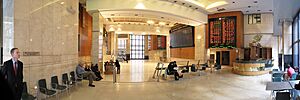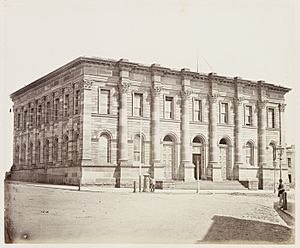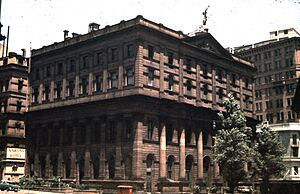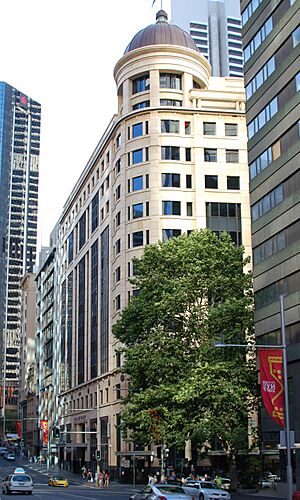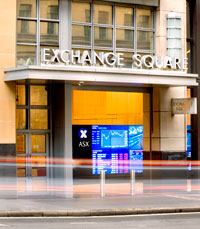Australian Securities Exchange facts for kids
| Australian Securities Exchange | |
|---|---|
Quick facts for kids Australian Securities Exchange logo.svg |
|
| Sydney Exchange Centre Entrance.jpg | |
| Type | Stock exchange, futures exchange, clearing house |
| Location | [[Sydney]], Australia |
| Coordinates | 33°51′50″S 151°12′32″E / 33.864°S 151.209°E |
| Founded | 1 April 1987 |
| Owner | ASX Limited ASX: ASX |
| Key people | Helen Lofthouse (CEO) |
| Currency | Australian dollar |
| No. of listings | 2,187 (January 2024) |
| MarketCap | A$2.6 trillion (January 2024) |
| Indexes |
|
The Australian Securities Exchange (often called ASX) is a very important company in Australia. It runs Australia's main stock market, where people can buy and sell shares in companies. The ASX was created on April 1, 1987. It brought together six smaller stock exchanges from different Australian states. Later, in 2006, it also joined with the Sydney Futures Exchange.
Today, the ASX is one of the biggest stock exchange groups in the world. It is the largest in the southern half of the world. Every day, about A$4.685 billion worth of shares are traded. The total value of all companies listed on the ASX is around A$1.6 trillion.
ASX Clear is like a special helper that makes sure all share trades are completed correctly. It handles shares, special products, and options.
Contents
What the ASX Does
The ASX Group does many things. It runs the market where shares are traded. It also helps clear and settle payments for these trades. The ASX checks that companies follow the rules. It also encourages good ways of running businesses among companies listed on the market. Plus, it helps teach everyday people about investing.
Australia's Financial Market
Australia has a strong financial market.
- It is ranked as one of the top financial systems in the world.
- Australia's stock market is the 8th largest globally. It is the 2nd largest in the Asia-Pacific region.
- The bond market is the 3rd largest in the Asia-Pacific.
- The market for financial tools like futures is the largest in the Asia-Pacific.
- The Australian dollar is the 5th most traded currency in the world.
- Australia has the largest amount of money managed in funds in the Asia-Pacific. This is partly because of its superannuation system, which is like a retirement savings plan.
How the ASX is Regulated
Several groups help make sure the ASX runs fairly and safely.
- The Australian Securities & Investments Commission (ASIC) watches over trading on the market. It also checks how companies and their clients behave. ASIC also makes sure the ASX itself follows its own rules.
- ASX Compliance is a part of the ASX. It makes sure that companies listed on the ASX follow the rules.
- The Reserve Bank of Australia (RBA) checks the ASX's systems for clearing and settling trades. This helps keep the financial system stable.
Products Traded on the ASX
You can trade many different things on the ASX. These include:
- Shares in companies
- Futures (agreements to buy or sell something later)
- Options (the right, but not the obligation, to buy or sell something)
- Exchange-traded funds (ETFs), which are like baskets of different investments.
- Real estate investment trusts (REITs), which let you invest in property.
- Interest rate securities, which are like loans that pay interest.
Some of the biggest companies traded on the ASX are BHP, Commonwealth Bank, Westpac, Telstra, Rio Tinto, National Australia Bank, and Australia & New Zealand Banking Group.
The main index that shows how the market is doing is the S&P/ASX 200. This index includes the top 200 companies on the ASX. Other important indexes are the S&P/ASX 100 and S&P/ASX 50.
History of the ASX
The ASX started a long time ago, in the mid-1800s. Six separate stock exchanges were set up in Australia's main cities. These were in Melbourne (1861), Sydney (1871), Hobart (1882), Brisbane (1884), Adelaide (1887), and Perth (1889).
In 1937, these exchanges formed a group called the Australian Associated Stock Exchanges (AASE). This group helped create common rules for all the exchanges.
Before computers, trading was done in person. Employees called "chalkies" wrote down bids and offers on blackboards. This system changed in 1987 when the ASX was officially formed. It brought all six state exchanges together into one national exchange.
In 1998, the ASX became the first stock exchange in the world to have its own shares listed on its own market. This means you could buy shares in the company that runs the stock exchange!
Important Moments in ASX History
- 1861: Australia's first stock exchange opened in Melbourne. This was ten years after the Gold Rush began.
- 1871: The Australian Gas Light Company became the second company to be listed on the Sydney Stock Exchange.
- 1885: The Broken Hill Proprietary Company Limited (BHP), a big mining company, listed on the Melbourne Stock Exchange.
- 1937: The Australian Associated Stock Exchanges (AASE) was officially created. This group helped make rules for all the state exchanges.
- 1938: The first share price index was published. This is a number that shows how the market is doing overall.
- 1939: The Sydney Stock Exchange closed for the first time because World War II started.
- 1960: The Sydney Futures Exchange began trading. It helped wool traders manage risks.
- 1980: The separate stock exchange indexes for Melbourne and Sydney were replaced by national Australian Stock Exchange indexes.
- 1984: The fees brokers charged for trades became flexible. This made trading cheaper over time.
- 1987: The Australian Stock Exchange Limited (ASX) was officially formed. This combined all the state exchanges into one. A new electronic trading system called SEATS was also launched.
- 1998: The ASX became a listed company itself. It was the first exchange in the world to do this.
- 2006: The ASX merged with the Sydney Futures Exchange.
How Trading Works
The ASX Group uses two main computer systems for trading. ASX Trade is for buying and selling shares. ASX Trade24 is for trading futures and other similar products.
ASX Trade is a very fast system. It can process trades in a tiny fraction of a second. ASX Trade24 is a global system that allows trading 24 hours a day.
Opening Hours
The ASX is open for trading from Monday to Friday. It is closed on national public holidays like New Year's Day, Australia Day, Good Friday, Easter Monday, Anzac Day, King's Birthday, Christmas Day, and Boxing Day.
On trading days, there's a pre-market session from 7:00 am to 10:00 am Sydney time. The main trading session is from 10:00 am to 4:00 pm Sydney time. The market opens gradually, with different companies starting to trade over the first ten minutes.
When you own shares, you don't usually get a paper certificate. Your shares are recorded electronically in one of two ways:
- CHESS: Your broker helps you set up a "holder identification number" (HIN). You get monthly statements showing your shares.
- Issuer-sponsored: The company whose shares you own keeps a record of your shares. You get a "security-holder reference number" (SRN).
You can easily move your shares between these two systems or between different brokers.
The ASX runs a fun game called the ASX Sharemarket Game. It lets people, including high school students, learn about investing. Players get a pretend $50,000 to buy and sell shares. They can watch how their investments do over time, using real market prices. It's a great way to learn without risking real money!
See also
 In Spanish: Australian Securities Exchange para niños
In Spanish: Australian Securities Exchange para niños
- Economy of Australia
- Australian Securities and Investments Commission
- All Ordinaries
Lists
- List of stock exchanges
- List of futures exchanges
- List of Australian exchange-traded funds


